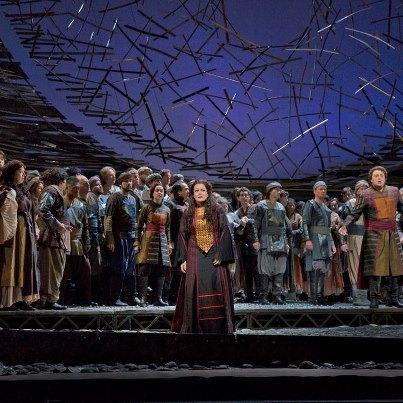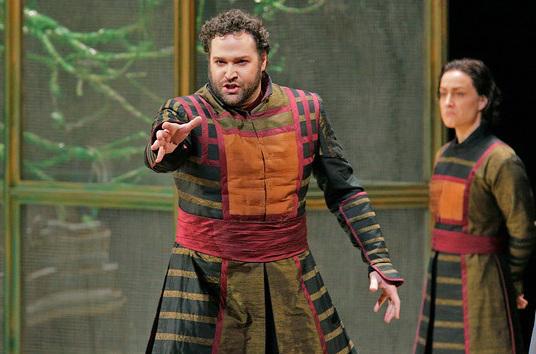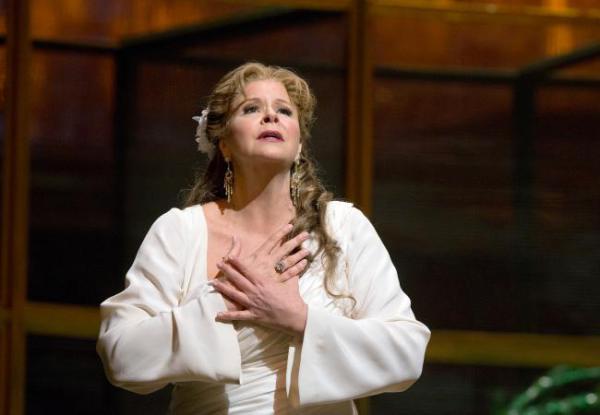
Deborah Voigt as Cassandra in Les Troyens (pt-br,facebridge.net)
Hector Berlioz (1803-1869) was truly a one-of-a-kind compositional genius. Not for him was the quaintness of Cherubini, Grétry or Méhul. No, his operatic role model was the great reformer Gluck, whose texts were taken from classical antiquity. Berlioz continued the trend by borrowing liberally from such masters as Shakespeare, Virgil, Byron and Goethe. This marked him out as a 19th-century rebel of the Romantic kind.
Unappreciated and misunderstood in his lifetime, today the French composer’s music is instantly recognizable – and for a variety of reasons, first for their coloristic elements (i.e., an exceptionally high quotient of woodwind, brass, choral and percussive effects), along with their originality, ingenuity and character. His output of operas and large-scale concert works – from the trailblazing The Damnation of Faust and Benvenuto Cellini, to his choral-symphonic Roméo et Juliette and comedic Beatrice and Benedict, as well as the reverent L’Enfance du Christ (“The Childhood of Christ”) and the massive Requiem – have all enjoyed a modern resurgence, with a handful or so belatedly joining the standard repertory, a most welcome inclusion.
The main difficulty I find with producing many of Berlioz’s stage works is their nonconformity to the accepted norms of the past. For example, the majority of his operas begin with no prelude or introduction to set the scene or mood. His scenes and arias are melodically flavorful and well-thought-out, especially those for mezzo-soprano and tenor. Yet his dramatic sense is unlike that of any other composer I’ve encountered, in that his tales simply come to an abrupt halt – no big “ta-da,” no huge orchestral outbursts, no vocal demonstrations or bombastic coups des théâtres in the Wagnerian mode; they just plainly and quite modestly end… period. This is what makes them so unique, and radio listeners were indeed fortunate to hear the January 5th Metropolitan Opera broadcast of his two-part, five-act Les Troyens (“The Trojans”), based on Virgil’s Aeneid.
As one could imagine, Berlioz was most taken with the psychological aspects of the story, in particular the two female leads, the prophetess Cassandra and the Carthaginian Queen Dido, who each face such despair that, in the end, turns into terrible tragedy not just for them both but for their two countries as well.
Among the myriad challenges in staging a work of this magnitude is to find a company of artists willing and able to do the gargantuan piece justice. Still, all praise and honor should go to the Met Opera chorus, who received the lion’s share of attention for their masterly, inexhaustible contribution to this demanding opus. Also worthy of mention is principal conductor Fabio Luisi, who led an expertly detailed performance – one of his finest to date, I must say. The frequent brass fanfares and orchestral episodes, including a wonderfully descriptive Royal Hunt and Storm, in addition to the numerous dance interludes and offstage sound effects, were all handled with the nuance and skill this miraculous score deserves; with additional kudos to the first clarinetist for his/her mournful solo during the fallen Hector’s funeral procession in Act I.
The big news, prior to show time, was the announcement that Sicilian tenor Marcello Giordani had withdrawn from his scheduled appearances as Énée (Aeneas), the Trojan War hero who through various circumstances goes on to found the city of Rome. Giordani subsequently announced that he had permanently dropped the part from his repertoire. Understandably so, since Énée is what we opera buffs like to refer to as a “killer” role. It’s not that it’s a long part. In fact, compared with Wagner’s Tristan or Siegfried, there’s not all that much to sing: a brief solo number in Act I, the scene with Hector’s Ghost in Act II, followed by Énée’s arrival in Carthage in Act III, the rapturous love duet with Queen Dido in Act IV, and the strenuous farewell in Act V. The “killer” aspect, however, kicks in with the treacherously stratospheric vocal range. Those high C’s and D’s can drive anyone to drink. Berlioz deliberately designed this aspect to reflect the character’s constantly fluctuating state of mind. In other words, it’s a dramatic device but one achieved through purely musical means. A masterstroke!

Bryan Hymel as Énée (super-conductor.blogspot.com)
No matter how we explain it, though, Énée remains a notoriously trying assignment, and to think that Jon Vickers, Placido Domingo and Ben Heppner (among others) once gave it their all speaks volumes for the attraction this role has had for aspirants. We can thank the theater gods for providing the radio audience with a viable, if not well-nigh perfect substitution in New Orleans-born Bryan Hymel (pronounced EE-mel). At the eleventh hour, tenor Hymel rescued The Trojans from oblivion (both literally and figuratively) in a performance that will go down as one of the greatest tenor triumphs of the past 20 years. His broadcast debut yesterday, which was beamed live to the U.S. and throughout the world via the Met’s Live in HD series, was watched and listened to by millions.
I’m pleased to report that Hymel was an absolute sensation! His voice, a pleasant mixture of both the young Vickers and the mature Domingo, with a touch of Cajun French to his sound, is a thing of rare beauty. Not to belabor the point, but Hymel hit every high note squarely and securely (I hear a Tristan and/or Otello in his future). In addition, he showed an uncanny acting ability (yes, even on the radio, one could tell he was living every moment of the tragic hero’s plight). For once, here was a tenor who threw caution to the winds to generate some excitement for a change. After his Act V lament, “Inutiles regrets” (“Useless regrets”), a last-minute water-torture moment for any tenor, the live audience gave him a rousing and well-earned roar of approval that went on for several spine-tingling minutes. At the final curtain, Hymel was greeted with a huge standing ovation. (The Met has been lucky with their pinch-hitting tenor contingent: last year, Jay Hunter Morris stepped in at the last minute to salvage the house’s terribly expensive Ring cycle project with a more than credible assumption of Siegfried.)
Baritone Dwayne Croft, who I often find over-parted in some of his Italian roles, here was a model Chorèbe in Part I, while bass Kwangchul Youn as Narbal and the Voice of Mercury lent a sepulchral presence throughout. The minor roles of Iopas and the sailor Hylas, who opens Act V with a nostalgic song about his homeland, were both well sung by Eric Cutler and Paul Appleby, respectively.
The women were on an equal footing with the men, in particular the expansive and gorgeously phrased Queen Dido of Susan Graham. This extraordinary artist has made a career out of put upon female parts. In the past, she’s excelled as the Composer from Ariadne auf Naxos, Charlotte in Werther, and Marguerite in The Damnation of Faust.

Susan Graham as Dido (minnesota.publicradio.org)
The French and German roles do appear to be her specialty, and I must say she sang Dido magnificently. I did notice a slight tiring toward the end of this marathon assignment, though, an ever-so-slight grating in her throat (possibly, a holdover from the cold that had sidelined her earlier in the run), but beyond that she was above reproach. Visually, she must have been stunning to look at (I’ve seen her often on PBS and other telecasts from the Met, and she’s been on the cover of Opera News on several occasions, so I can vouch for her appearance). Graham is also a knowledgeable interview host and a sparkling TV and radio personality.
As for Deborah Voigt, the Met’s dependable Brünnhilde in the Met’s Ring cycle and a chatty personality in her own right, she played Cassandra, intelligently one should add. During the intermission feature, Voigt mentioned that this was her one and only French role, which I found startling since this part seems to be a natural fit for her voice category. Personally, I’ve always felt she was straining under all those Strauss heroines. Her last outing, in the execrable Die Aegyptische Helen (“The Egyptian Helen”), was undone by a ludicrous staging. Her Wagner has also seen better days. With her slimming down a few years back she now cuts a trim stage figure, but at the loss of some tonal “body.” This is all a question of placement and thrust, especially in a house as large as the Met. I am sure she’ll overcome these minor hurdles and be back in fighting form soon.
Stylistically, some of Voigt’s Italian roles were, how shall I put this, decidedly un-Italian. She should be wary of such works as Tosca, Andrea Chenier and La Gioconda from now on, and please give good old Minnie in La Fanciulla del West a rest. Let’s face it: Puccini and verismo is clearly not her cup of tea! For the sake of her many fans, we’d like her to stick with the French repertoire, if she can. It’s her safest bet, vocally and linguistically. Speaking of which, Voigt’s French pronunciation, while not exactly that of a native Parisian, was more than acceptable.
This broadcast earns my highest rating: A+ to all.
Copyright © 2013 by Josmar F. Lopes

